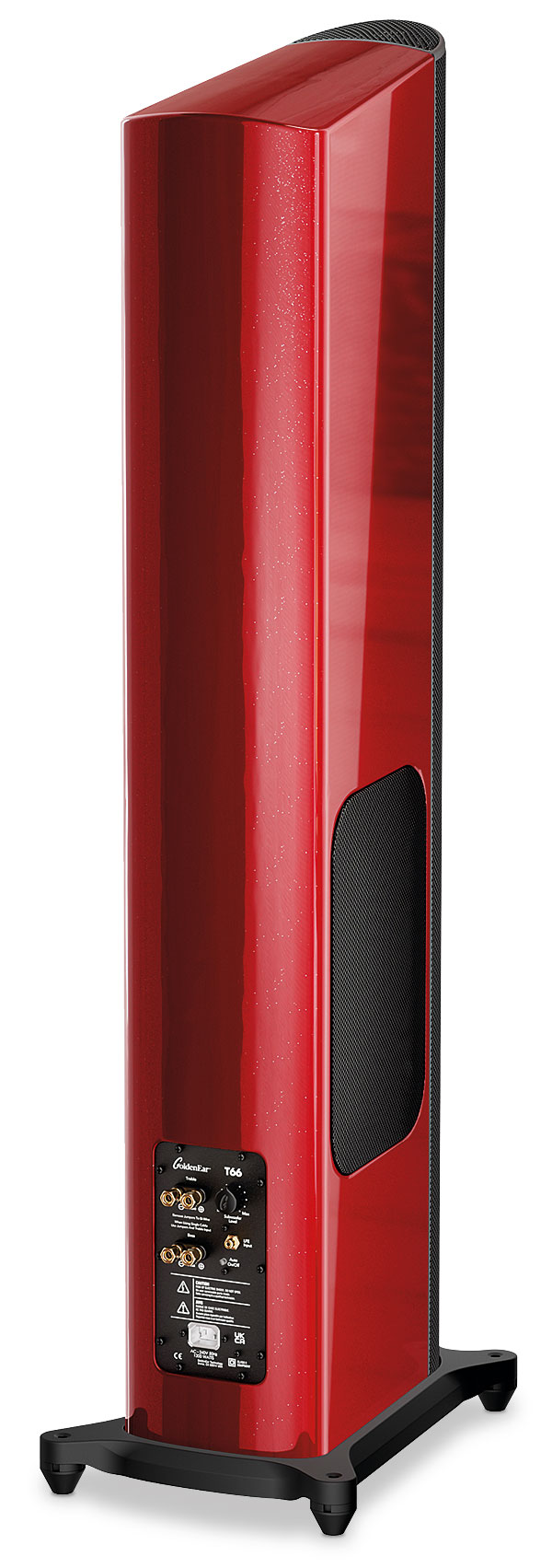GoldenEar T66 Loudspeaker Page 2
![]() Body And Soul
Body And Soul
Because of its DSP bass control, the T66 offers a different listening experience to an equivalent passive three-way design. For one thing, you don't need to really crank the volume up high to be treated to a full-bodied bass performance. This was the case with GoldenEar's earlier Triton hybrid models too, the difference being now that the low-end delivery of the T66 is a little less overassertive and feels tighter.
The result is a loudspeaker with a better balance overall. Not only is the sound less dense and compact in terms of imaging, but fine detail is presented in a more airy and open fashion. In other words, while never quite displaying ultimate resolution, the GoldenEar T66 has the audiophile character its designers were aiming for. Anyone used to the erstwhile 'American' tuning, which sometimes seemed more suited to home theatre than hi-fi, will be pleasantly surprised. The interplay between the T66's passive drivers and its active woofers delivers spacious detail on an expansive soundstage that has the rock-solid foundation you would expect from a son of Triton. A benefit of the semi-active DSP-controlled approach is that the T66 generally remains in equilibrium, even at lower volumes. Sure, there's no beating physics, but bass presence didn't evaporate when I turned down the wick during 'Alive' on the Deadmau5/Kascade techno collaboration Kx5 [Mau5trap Recordings MAU50533A1X].
Rhythm Master
Returning to a more respectable sound level, and with the bass dial set to the two o'clock position for added oomph, I was met by a massive wall of sound. In that sense the T66 is still very much true to the original GoldenEar intent, being capable of jaw-dropping amounts of controlled low-frequency fun. Even better, though, this bass punch is part of a detail-packed soundfield extending beyond the cabinets, which gave the vocals by Brit singer Hayla, on Kx5's technopop track 'Espace', plenty of textured character and a distinct position in the mix.

The African-influenced polyrhythms of the opening song on Beverly Glenn-Copeland's new The Ones Ahead set [Transgressive TRANS674CD] can leave less adept loudspeakers struggling to remain coherent, but the T66 let the various drums and percussion instruments flow freely with a first-rate sense of speed and rhythm. And while it did tend to push the vocals forward, making Glenn-Copeland's chanting a bit 'in your face', that at least let me savour the finer vocal highlights in the mellower tracks 'Love Takes All' and 'The Ones Ahead'.
To top it off you don't need a massive power amplifier to drive these speakers, as the built-in active subwoofer is taking care of the difficult low-end. The Riviera Levante amp I mainly used for auditioning the T66 was happy to deliver the goods in its claimed 30W Class A mode, with an Accuphase DP-560 DAC/SACD player and Primare NP5 II streamer acting as sources. In this set-up, the T66 both communicated the subtle flutes and clarinets of Antonín Dvořák's 'The Water Goblin' [Life With Czech Music; Supraphon SU 4041-2] while delivering the visceral thrill of an orchestra at full blast.
Full Speed
This performance, conducted by Charles Mackerras, takes you straight to the heart-pounding action as it begins with the fast-paced Slavonic Dances (Presto). Even though the T66 has greater refinement and politeness than the 'old' GoldenEar models, it still grabbed my attention with its mighty dynamics and speed.
Tomaso Albinoni's beautiful Adagio in G Minor, as performed by the Academy of Saint Martin in the Fields in 1973 [Warner Music download; 44.1kHz/16-bit], also let the T66 strut its stuff. The rich church organ and deftly portrayed strings ensured the piece's melancholic atmosphere was on full view, without the performance becoming distant or cold. Overall, these sensibly sized speakers from GoldenEar perform like a substantially grander sound system. If the T doesn't stand for Triton, maybe it stands for 'terrific'?
Hi-Fi News Verdict
The T66 is a more accomplished offering than GoldenEar's previous midrange hybrid floorstander, while still staying true to the brand's identity. It's a rewarding listen capable of communicating dynamics, excitement and airiness – as well as spectacular bass extension. And best of all? This balancing act is achieved without need of a huge powerhouse amp to drive it. Red or black, the T66 is worth a bet…
























































